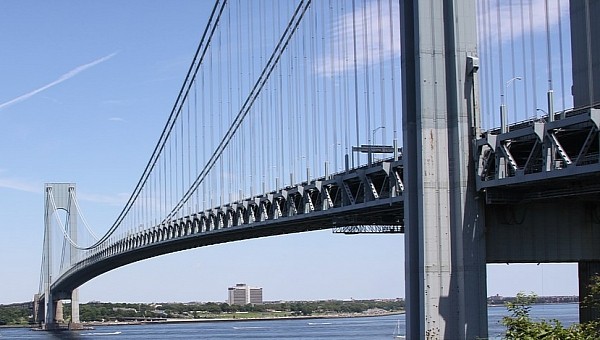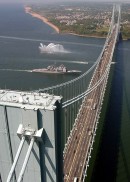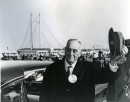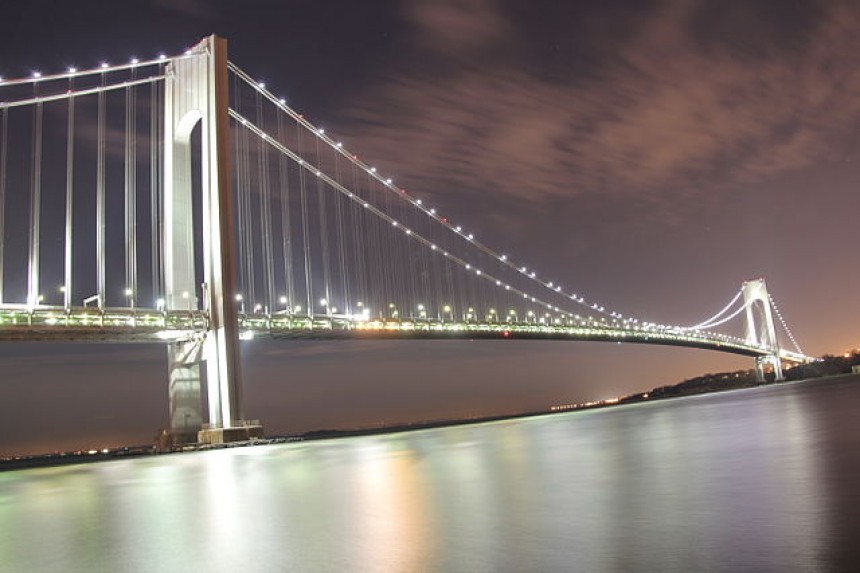A bridge designed for carrying passenger cars in a major metro area tends to develop a certain unsavory mythos about itself, whether it's merited or not. In New York City, several bridges and tunnels have this reputation. But where you tend to expect a degree of chaos on the George Washington Bridge, another bridge in the city is even more polarizing.
That bridge is the Verrazzano-Narrows Bridge between the Bay Ridge neighborhood of Brooklyn and Staten Island, the city's scrappy underdog of a fifth Borough. This being New York City, a place rife with tales of corruption, power plays, and inter-city politics, the Verazzano-Narrows bridge has a history steeped in controversy dating back to decades before the bridge was built.
Before the V-N Bridge, the Staten Island Ferry was the fashionable way to get between New York City's four core boroughs to the more isolated Staten Island. The practice of using either steam or diesel-electric boats to navigate around New York Harbor en-masse dates back, at the very least, to the year 1817. Even today, their annual ridership touches on the tens of millions.
But the challenge of transporting large numbers of cars, trucks, and motorcycles on top of all the people driving them presented a problem. By the end of the 19th century, it was apparent that something more was needed to prevent a complete bottleneck of New York Harbor.
Even so, it took until at least 1926 for a formal bridge-related proposal to come across the desk of New York City lawmakers. The design in question came from the noted American civil engineer David B. Steinman. Steinman was the same brilliant mind responsible for designing the 26,372-foot (8,038 m) long Mackinac Bridge between St. Ignace and Mackinaw City, Michigan.
Steinman presented an idea to the joint chambers of commerce of Brooklyn, Queens, Long Island, and Staten Island for an interborough bridge with towers at least 800 feet (240 m) tall. This concept was dubbed the Liberty Bridge. For reasons that are still not entirely clear, the project was never voted upon.
Prior to this, in 1923, a design was proposed for a tunnel-based solution to the Staten Island issue. This would've simultaneously brought car and truck traffic, but also the New York City subway direct access to Staten Island in an unprecedented capacity. In the end, both Federal and New York City elected officials bickered and argued over what to do for decades.
That was, until August 13th, 1959, when the self-made design of the famed Swiss-American Othmar Ammann began construction with the man himself overseeing the project. His other associations in automotive bridges include the George Washington Bridge, the Throgs Neck Bridge, and Bronx-Whitestone Bridge, the Queens Triborough Bridge, and San Francisco's Golden Gate Bridge. As far as an automotive resume goes, that's got to be up there with Henry Ford.
Named after the first European explorer to discover New York Harbor, the construction of the bridge required well over 300,000 cubic yards (229,366.7 cubic meters) of concrete just to finish the foundations. First opened on November 21st, 1958, the Verrazano-Narrows is still the longest suspension bridge purposely built for automobiles in the Americas. With two decks on offer and at 13,700 feet (4,176 m) in total length, the Verrazanno-Narrows Bridge has found controversy in its ever-increasing toll costs.
From 1986 until 2020, only the bridge's westbound lanes received a toll bill in an effort to ease the V-N's other notorious problem, the seemingly unending traffic jams. It's a key identifying feature of any of New York City's great auto bridges, from the George Washington to the Tappen Zee and everything in between.
But starting in late 2020, the eastbound lanes of the bridge are now also subject to a $10.17 toll charge processed either through EZ bass or billed via license plates. At a time when the cost of living in NYC is soaring to the stratosphere, bridge tolls are just another thorn in the side of a city that's getting harder and harder to live in every year.
Happily, we've established a handy little guide that can help you avoid as many tolls as possible on your next road trip to the big apple. Check that out here if you want to learn more. For now, let's light 58 OSHA-approved candles for what, at the very least, is still a New York landmark.
Before the V-N Bridge, the Staten Island Ferry was the fashionable way to get between New York City's four core boroughs to the more isolated Staten Island. The practice of using either steam or diesel-electric boats to navigate around New York Harbor en-masse dates back, at the very least, to the year 1817. Even today, their annual ridership touches on the tens of millions.
But the challenge of transporting large numbers of cars, trucks, and motorcycles on top of all the people driving them presented a problem. By the end of the 19th century, it was apparent that something more was needed to prevent a complete bottleneck of New York Harbor.
Even so, it took until at least 1926 for a formal bridge-related proposal to come across the desk of New York City lawmakers. The design in question came from the noted American civil engineer David B. Steinman. Steinman was the same brilliant mind responsible for designing the 26,372-foot (8,038 m) long Mackinac Bridge between St. Ignace and Mackinaw City, Michigan.
Prior to this, in 1923, a design was proposed for a tunnel-based solution to the Staten Island issue. This would've simultaneously brought car and truck traffic, but also the New York City subway direct access to Staten Island in an unprecedented capacity. In the end, both Federal and New York City elected officials bickered and argued over what to do for decades.
That was, until August 13th, 1959, when the self-made design of the famed Swiss-American Othmar Ammann began construction with the man himself overseeing the project. His other associations in automotive bridges include the George Washington Bridge, the Throgs Neck Bridge, and Bronx-Whitestone Bridge, the Queens Triborough Bridge, and San Francisco's Golden Gate Bridge. As far as an automotive resume goes, that's got to be up there with Henry Ford.
Named after the first European explorer to discover New York Harbor, the construction of the bridge required well over 300,000 cubic yards (229,366.7 cubic meters) of concrete just to finish the foundations. First opened on November 21st, 1958, the Verrazano-Narrows is still the longest suspension bridge purposely built for automobiles in the Americas. With two decks on offer and at 13,700 feet (4,176 m) in total length, the Verrazanno-Narrows Bridge has found controversy in its ever-increasing toll costs.
But starting in late 2020, the eastbound lanes of the bridge are now also subject to a $10.17 toll charge processed either through EZ bass or billed via license plates. At a time when the cost of living in NYC is soaring to the stratosphere, bridge tolls are just another thorn in the side of a city that's getting harder and harder to live in every year.
Happily, we've established a handy little guide that can help you avoid as many tolls as possible on your next road trip to the big apple. Check that out here if you want to learn more. For now, let's light 58 OSHA-approved candles for what, at the very least, is still a New York landmark.












